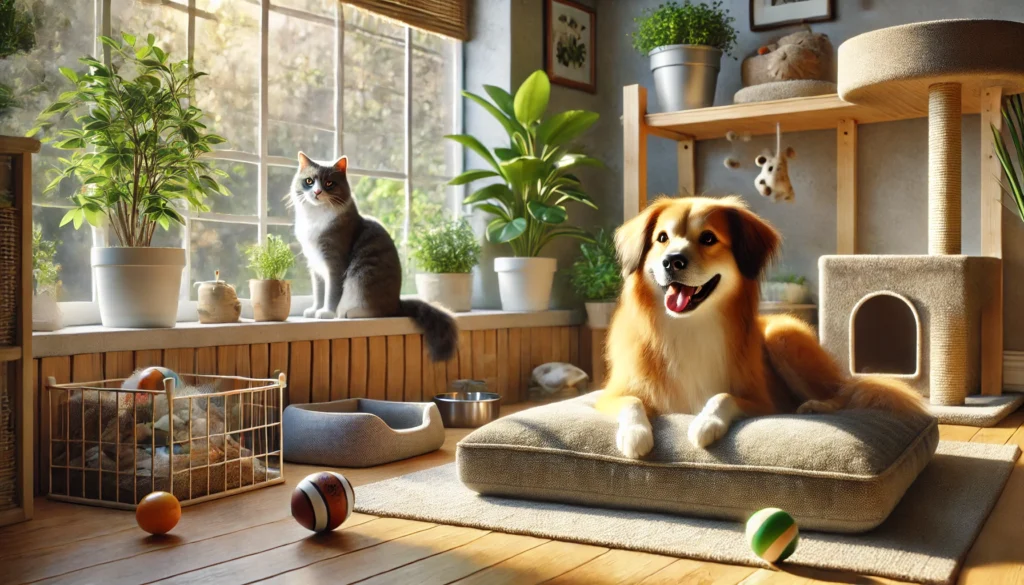Having dogs and cats living indoors is increasingly common. Whether it’s due to safety, comfort, or limited space, indoor living can be a great experience for pets — as long as it’s well planned. But how do you make sure your pets are not just safe, but also happy indoors?
This article brings practical, day-to-day tips for making your home a cozy, stimulating, and pet-friendly place for your furry companions.
Creating a Comfortable Environment
Pets need their own safe and comfortable spaces inside the house. This doesn’t mean buying expensive furniture or luxury beds — just paying attention to details that matter.
Dedicated Resting Areas
- Choose a quiet area away from heavy foot traffic or noise.
- Provide a soft, washable bed or blanket.
- Keep it warm in winter and cool in summer.
Temperature and Lighting
- Make sure the space has proper ventilation.
- Avoid direct sunlight during summer afternoons.
- Offer cozy options during colder months, especially for cats who love warm corners.
Daily Routines Are Essential
Dogs and cats thrive on routine. Just like humans, knowing what to expect each day helps them feel secure.
Feeding Schedule
- Feed your pets at consistent times daily.
- Don’t leave food out all day; create a structure.
- Always have fresh, clean water available.
Playtime and Interaction
- Dedicate time every day to play and interaction.
- Use toys like balls, feather wands, or interactive puzzles.
- Rotate toys weekly to avoid boredom.
Enrichment to Stimulate Their Minds
Indoor pets can become bored without enough stimulation. Mental enrichment is just as important as physical exercise.
For Dogs
- Hide treats around the house for them to find.
- Teach simple commands and tricks regularly.
- Use puzzle feeders to make mealtime more engaging.
For Cats
- Set up a window perch so they can watch the outside world.
- Use cat trees or wall shelves to encourage climbing.
- Offer scratchers made of different textures.
Keeping the Home Clean (and Pet-Safe)
A clean environment is healthy for both humans and animals — and yes, it’s possible to keep your home neat even with pets indoors.
Fur Control
- Brush your pets regularly to reduce shedding.
- Use a vacuum with a pet-hair attachment.
- Wash bedding weekly to remove dander and odors.
Accidents Happen
- Keep enzymatic cleaners on hand for occasional accidents.
- Train your pets early on to use litter boxes or designated spots.
- Clean food and water bowls daily.
Socialization and Emotional Needs
Even indoor pets need a sense of connection — with you, with each other, and with the world.
Interaction with Humans
- Talk to your pets regularly — they do recognize your tone.
- Gentle petting and cuddles build trust and affection.
- Include them in your routine when possible (like relaxing on the couch or reading).
If You Have Multiple Pets
- Ensure each has their own space and resources.
- Feed separately if needed to avoid food aggression.
- Encourage shared playtime, but respect their boundaries.
When You’re Not Home
One of the biggest challenges for indoor pets is staying alone when you’re out for work or errands.
Tips to Keep Them Calm and Occupied
- Leave toys and treats hidden around the house.
- Turn on a pet-friendly playlist or white noise.
- Consider a camera with two-way audio if you’re gone for long hours.
Managing Energy Indoors
Many people believe pets need outdoor time to be healthy — and while walks are great, it’s not the only way to burn energy.
Exercise Alternatives
- Play short, frequent sessions throughout the day.
- Create obstacle courses using furniture.
- Use interactive feeders that require effort to get the food.
Seasonal Adjustments
Each season brings its own set of challenges and needs.
Summer
- Keep pets indoors during the hottest hours.
- Ensure water is cool and shaded.
- Use cooling mats if needed.
Winter
- Provide extra blankets or heated pet beds.
- Watch out for dry skin due to heaters.
- Keep their paws clean and moisturized if exposed to cold surfaces.
Health Monitoring at Home
You don’t need to be a vet to keep an eye on your pet’s well-being.
Daily Checks
- Monitor appetite and energy levels.
- Watch for excessive scratching or licking.
- Check for signs of discomfort or hiding behavior.
If anything seems off, schedule a vet visit promptly. Early action makes a big difference.
Final Thoughts: Making Indoors Feel Like Home
Living indoors doesn’t have to limit your pet’s happiness. With a bit of structure, creativity, and affection, your home becomes a complete environment for dogs and cats to live well and thrive. It’s not about having a perfect space — it’s about having a space filled with love, safety, and attention.
Remember: happy pets make a happy home.






